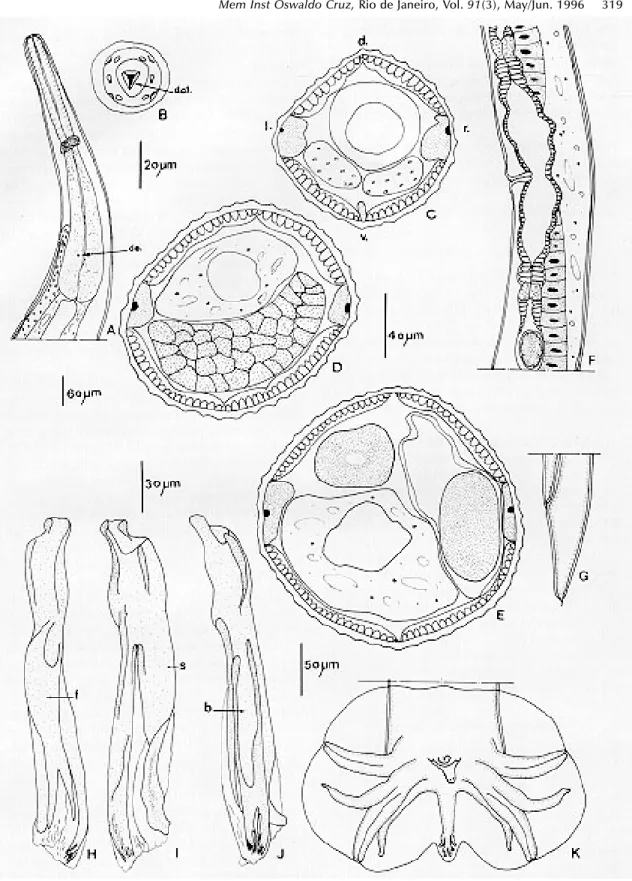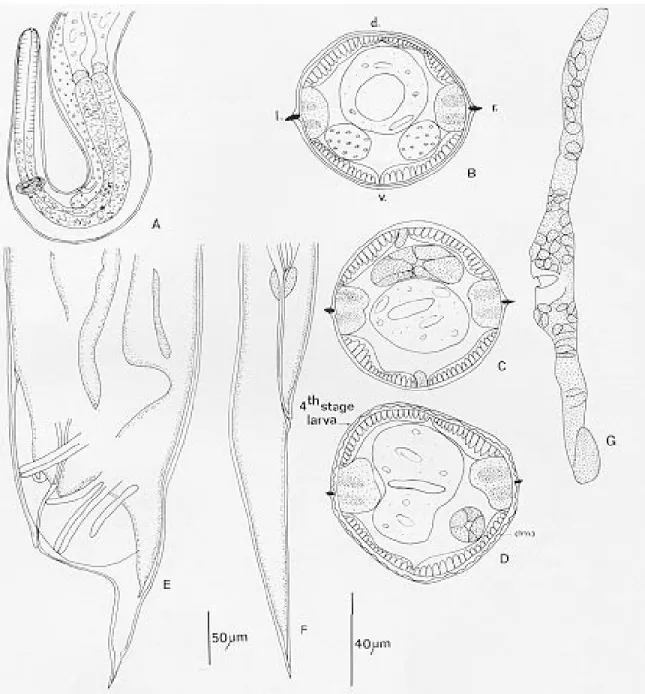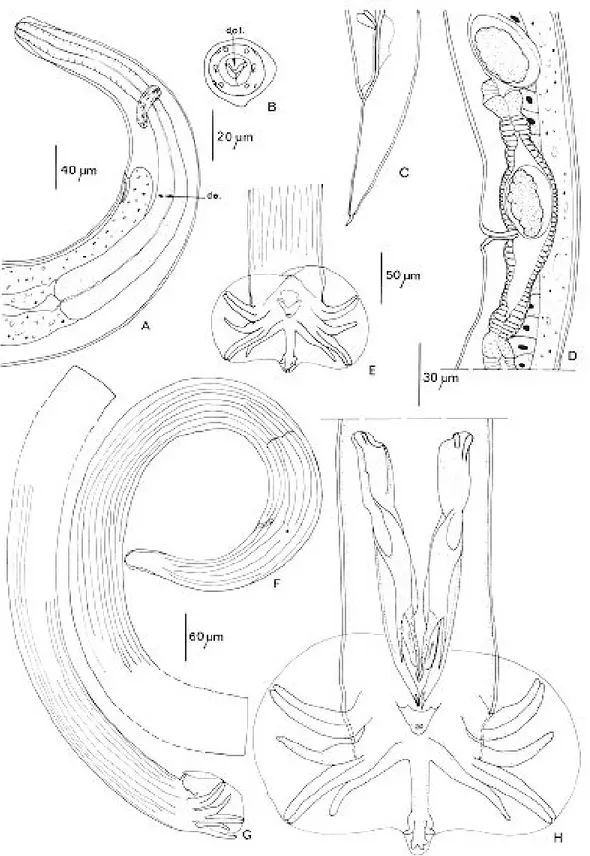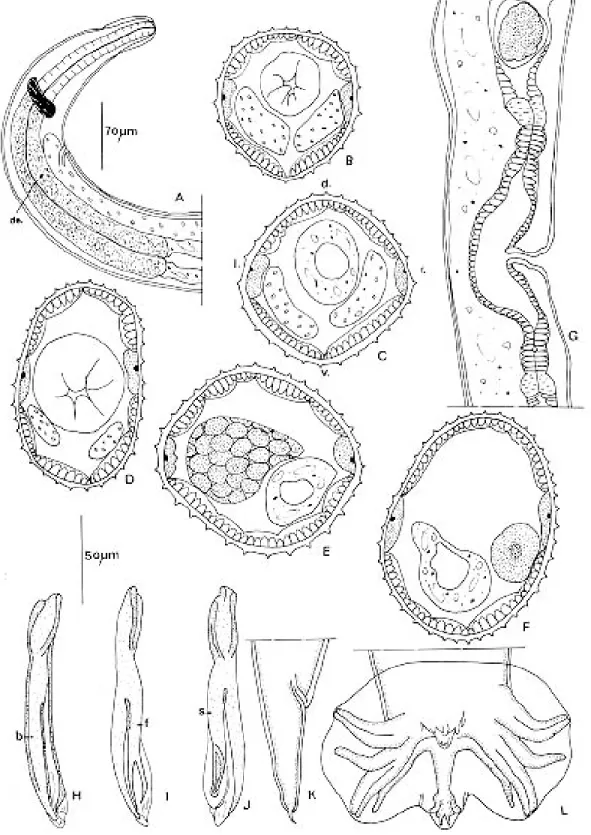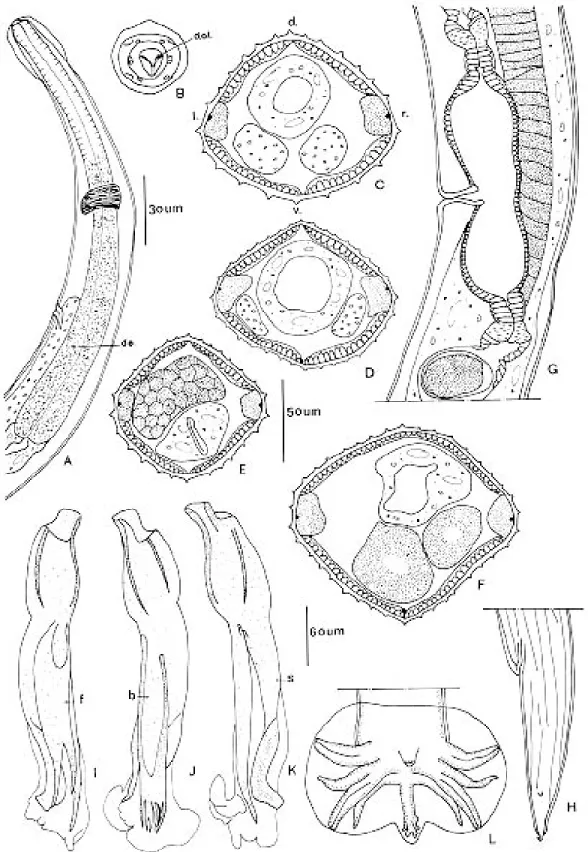317
Mem Inst Oswaldo Cruz, Rio de Janeiro, Vol. 91(3): 317-328, May/Jun. 1996
Four New Species of
Oswaldocruzia
(Nematoda:
Trichostrongylina, Molineoidea) Parasitizing Amphibians
and Lizards from Ecuador
Badreddine Ben Slimane, Marie-Claude Durette-Desset
+Laboratoire de Protozoologie et Parasitologie coniparée de l’E.P.H.E. & Laboratoire de Biologie Parasitaire, Protistologie, Helminthologie, associé au C.N.R.S., Muséum National d’Histoire Naturelle, 61 Rue Buffon,
75231 Paris Cedex 05, France
Description of four new species of Oswaldocruzia parasitizing Iguanidae and Leptodactylidae from Ecuador, demonstrate that they are morphologically close to each other. Like most of the other neotropical and holarctic Oswaldocruzia, they are characterized by spicules with three main branches: blade, shoe and fork; the division of the fork within the distal third of the spicule length appears to be characteristic of the neotropical species.
- Oswaldocruzia bainae n. sp. parasitizing Anolis chrysolepis and Anolis fuscoauratus possesses a synlophe visible only on transversal sections of the body. It is composed of rounded and not pointed ridges.
- Oswaldocruzia tcheprakovae n. sp. parasitizing Eleutherodactylus altamazonicus isclosely related to O. bainae, but the synlophe is present only in the anterior and posterior extremities of the body.
- Oswaldocruzia cassonei n. sp. parasitizing Eleutherodactylus lanthanites is closely related to O. taranchoni, Ben Slimane and Durette-Desset, 1995, a parasite of Bufo marinus from Brazil. It is differ-entiated by the synlophe and the measurements.
- Oswaldocruzia petterae n. sp. parasitizing Leptodactylus pentadactylus is closely related to O. chambrieri, Ben Slimane and Durette-Desset, 1993, parasitizing Bufo and Eleutherodactylus in the same region. It is differentiated since, for an equivalent length of the body, the ridges are almost two times fewer and the spicules smaller.
Key words:Oswaldocruzia n. spp.- Nematoda - Trichostrongylina - lguanidae - Leptodactylidae - Ecuador
In this study, we continue the review of the genus 0swaldocruzia Travassos, 1917, a cosmo-politan parasite of Amphibians and Reptiles. The diagnosis of the species relies on new morphologi-cal criteria, particularly the synlophe characteris-tics in oesophageal region, the relative arrangement of rays 6 and 8 of the caudal bursa and the acute spicular morphology.
Six species of Oswaldocruzia were described in Ecuador (cf Ben Slimane & Durette-Desset, 1993, 1995), but only from Amphibians. We de-scribe below three new species in Amphibians and one in Reptiles.
MATERIALS AND METHODS
The Nematodes were collected in the small in-testine of Ecuadorian Leptodactylidae and Iguanidae (neotropical fauna, guyano-brazilian sub-zona).
The study of the synlophe is based on the Durette-Desset (1985) method; the nomenclature of the synlophe in oesophageal region follows Ben Slimane et al. (1993). More particularly, the cer-vical alae are defined as one or more latero-ven-tral ridges, more developed than the other ridges. The nomenclature of the caudal bursa follows Durette-Desset and Chabaud (1981), concerning the relative arrangement of rays 6 and 8 follows that of Durette-Desset et al. (1992). The spicules were studied after dissection and the nomencla-ture is that of Ben Slimane et al. (1993).
The material was stored in 70° ethanol and de-posited in the Helminthological Collections of the Muséum National d’Histoire Naturelle of Paris (MNHN) and in those of the Muséum d’Histoire Naturelle of Genève (MHNG).
DESCRIPTION
The species are closely related to each other and to the other species previously studied in the same region. Some characters do not provide spe-cific differences and can be defined similarly for all the species.
+Corresponding author. Fax: 33-1-40 7934 99. E-mail:
Head: cephalic vesicle present without anterior swelling. En face view: buccal aperture triangular, with 6 externo-labial papillae, 4 cephalic papillae and 2 amphids. Small dorsal oesophageal tooth present.
Anterior extremity:excretory pore situated within distal third of oesophagus. Triangular-shaped deirids, posterior to excretory pore. Well devel-oped excretory glands. Musculo-glandular sepa-ration of oesophagus acutely visible at nerve ring level.
Caudal bursa:with 2-3 pattern which tends towards 2-1-2 i.e extremities of rays 4 directed towards anterior of body, nearer those of rays 3 than rays 5. Rays 2 and 3 joined along, rays 5 and 6 joined along. Rays 8 arising on root of dorsal ray and overlapped by rays 6 except in their distal extrem-ity (type III). Rays 9 arising on dorsal ray before division of the latter into two branches of which internal ones are longest. Thick dorsal ray. Gubernaculum absent.
Genital cone:15 µm high by 15 µm wide at its proximal part, bearing on anterior lipa large pa-pilla “zero” and 2 min papa-pillae 7 on posterior lip. Spicules: divided proximally into three main branches: extemo-lateral branch or blade, interno-dorsal branch or shoe, interno-ventrat branch or fork. Fork divided within distal third of spicule. Female: didelphic with very short infundibula.
Oswaldocruzia bainae n. sp.
Type-material:holotype male, allotype female MHNG-INVE 19484; 1 male, 3 females paratypes MNHN 212 MD
Host: Anolis chrysolepis (Iguanidae) Site: small intestine
Locality:San Pablo, Ecuador
Voucher specimens: from the same site and the same locality as the types
In 9 Anolis chrysolepis: 11 males , 5 L4 males, 16 females, 10 L4 females, MHNG-INVE 19485 to 19491. 7 male, 1 L4 male, 9 females, 1 entsheathed LA female, 2 L4 females MNHN 206 MD-207 MD. In 6 Anolis fuscoauratus: 12males, 3 females: MHNG-INVE 19492-19497; 2 males , 4 females: MNHN 219 MD.
ADULTS
Small nematodes with anterior part of body coiled or not. Cervical alae absent.
Synlophe: (studied in 1 male and 1 female paratypes, 1 male and 1 female from A. chrysolepis 2 males from A. fuscoauratus. Numbers in brack-ets correspond to voucher specimens).
In both sexes, cuticle bears longitudinal “pseudoridges” or undulations, uninterrupted whole length of body but obvious only in
trans-versal sections (Fig. 1C). Inmale 65% (74 to 77%) of ridges appear in oesophageal region, within 67% (74 to 78%) of dorsal ridges and 63% (71 to 81%) of ventral ridges. In female 81% (71%) of ridges appear in oesophageal region within same dorsal and ventral ratio. Ridges disappear just anterior to caudal bursa in male and at phasmids level in fe-male.
In male 27 (30, 34, 26) ridges at oesophago-intes-tinal junction (Fig. 1C) and 40 (40, 44, 35) at mid-body (Fig. 1D). In female, 44 (34) ridges at oesophago-intestinal junction and 54 (48) at mid-body (Fig. 1E).
In transversal sections, rounded ridges are more or less regularly spaced.
Holotype-male: 7100 µm long and 130 µm wide at mid-body. Cephalic vesicle 75 µm long and 40 µm wide. Nerve ring, excretory pore and deirids 190 µm, 380 µm and 400 µm from apex, respec-tively. Oesophagus 530 µm long.
Caudal bursa illustrated in Fig. 1K. Spicules 190 µm long, blade divided at its distal part into two small branches which are subdivided into numer-ous processes; fork distally divided at 17% of whole length of spicule (Fig. 1H-J).
Allotype-female:12350 µm long and 190 µm wide at mid-body. Cephalic vesicle 90 µm long and 40 µm wide. Nerve ring, excretory pore and deirids 190 µm, 370 µm and 390 µm from apex, respec-tively. Oesophagus 540 µm long (Fig. 1A). Vulva 4150 µm from caudal extremity, vagina vera 50 µm dividing vestibule 380 µmlong into two equivalent parts. Sphincters both 40 µm long and infundibula both 30 µm long (Fig.1F). Uterine branches both 2450 µm long with 70 eggs. All eggs at morula stage, 70 µm long and 50 µm wide. Tail 160 µm long and 70 µmwide at level of anus, with caudal spine 16 µmlong (Fig. 1G).
ENTSHEATHED IMMATURE STAGES:
(stud-ied in 1 male and 1 female from A. chrysolepis). Male:3200 µm long and 90 µm wide at mid-body. Nerve ring, excretory pore and deirids 170 µm, 310 µm and 330 µm from apex, respectively. Oesophagus 390 µmlong; beginning of formation of bursate rays (Fig. 2E).
Female:4100 µmlong and 90 µm wide at mid-body. Nerve ring, excretory pore and deirids 150 µm, 250 µm and 250 µm from apex, respectively. Oesophagus 370 µm long; tail 150 µm long and 40 µm wide at level of anus with caudalspine 18 µmlong.
Synlophe:same shape as in adult (Fig. 2D). 4TH STAGE LARVA:(studied in 1male and 1 female from A. chrysolepis)
319
Mem Inst Oswaldo Cruz, Rio de Janeiro, Vol. 91(3), May/Jun. 1996
alae holded by chitinous skeleton whole along the body (Fig. 2C).
Male: 3400 µmlong and 80 µmwide at mid-body. Nerve ring, excretory pore and deirids 175 µm,300 µm and 320 µm from apex, respectively. Oesophagus 390 µm long. Genital apparat 1450 µm long.
Female:3250 µm long and 70 µm wide at mid-body. Nerve ring, excretory pore and deirids150 µm, 240 µm and 240 µm from apex, respectively. Oesophagus 370 µm long (Fig. 2A). Genital apparat 610 µm long (Fig. 2G). Tail 110 µm long by 30 µmwide at anus level (Fig. 2F).
DISCUSSION
The specimens from Ecuadorian A. chrysolepis and A. fuscoauratus have no specific differentia-tion each other and belong to the genus Oswaldocruzia Travassos, 1917.
Among the numerous known species in the genus, those which present, as Ecuadorian speci-mens, spicules divided proximally into three main branches with a fork distally divided (within the distal third) seem characteristic of the neotropical zone.
The specimens described above possess: (1) a relative arrangement of the rays 6 and 8 of type III, i.e the rays 8 arise on root of the dorsal ray and are overlapped by therays 6 except at their distal extremity; (2) a spicular blade distally divided into numerous processes; (3) a poor developed synlophe with undulations and not sharp ridges.
Only one other neotropical species has the same synlophe: 0. peruensis Ben Slimane et al. (1995), a parasite of Peruvian Stenocercus roseiventris. It differs from the Ecuadorian specimens by the rela-tive arrangement of the rays 6 and 8 (type II) and by the presence of the cervical alae.
We consider the specimens from Anolis spp. as belonging to a new species 0swaldocruzia bainae n.sp., named after our colleague, Dr Odile Bain.
Oswaldocruzia tcheprakovae n.sp.
Type-material:holotype male, allotype female MHNG-INVE 19506, 1 L4 male, 5 female paratypes MNHN, 178 MD
Host: Eleutherodactylus altamazonicus
(Leptodactylidae) Site: small intestine
Locality: San Pablo, Ecuador ADULTS
Small nematodes, with anterior part of body coiled. Cervical alae absent.
Synlophe:(studied in the holotype and 1 paratype female). In both sexes, absence of synlophe ex-cept in anterior and posterior extremities of body
where ridges longitudinal. According to sex and level of body, ridges are rounded (undulations) or pointed.
In anterior extremity, ridges appear behind cepha-lic vesicle. In male, dorsal ridges disappear at about 640 µm from apex and ventral ones at about 700 µm. In female (7000 µm long), dorsal ridges dis-appear at about 1200 µmfrom apex (i.e three times length of oesophagus) and ventral ones at about 2400 µm (i.e a third of whole length). In posterior extremity, dorsal ridges of male (3650 µm long) visible at about 1400 µmfrom caudal bursa in trans-versal section of body but in toto, only at approximatively 450 µm; ventral ridges visible at about 250 µm. In female, ventral ridges appear at ovejector level and dorsal ones at anuslevel. In male, 16 dorsal ridges at 1400 µm to caudal bursa (Fig. 3I). Infemale, 26 ridges (13 dorsal, 13 ven-tral) at oesophago-intestinal junction (Fig. 3B), 13 ventral ridges at ovejector level (Fig. 3G) and 21 ridges at anus level (Fig. 3H).
In transversal section, pointed ridges are orientated perpendicularly to body surface. Undulations and ridges are both with same size and irregularly spaced. Holotype-male:3650 µm long and 70 µmwide at mid-body. Cephalic vesicle 50 µm long and 30 µm wide. Nerve ring, excretory pore and deirids 140 µm, 230 µm and 250 µm from apex, respec-tively. Oesophagus 370 µm long.
Caudal bursa illustrated in Fig. 4H. Spicules not dissected, 130 µm long. Blade divided at its distal part into two small branches. Subdivision of small branches not seen. Fork distally divided at 28% of whole length of spicule.
Allotype-female: 7350 µm long and 100 µm wide at mid-body. Cephalic vesicle 50 µm long and 30 µmwide. Nerve ring, excretory pore and deirids 150 µm, 280 µm and 300 µm from apex, respec-tively. Oesophagus 400 µm long (Fig. 4A). Vulva 2600 µm from caudal extremity. Vagina vera 30 µmlong dividing vestibule 180 µm long into two parts, posterior one being slightly shorter. Sphincters both 30 µm long and infundibula both 25 µm long (Fig. 4D). Anterior uterine branch 1800 µm long with 31 eggs, posterior uterine branch 1700 µm long with 28 eggs. All eggs at morula stage 70 µm long and 40 µm wide. Tail 140 µm long and 50 µm wide at level of anus, with caudal spine 15 µm long (Fig. 4C).
4TH STAGE LARVA MALE:2000 µm long and
321
Mem Inst Oswaldo Cruz, Rio de Janeiro, Vol. 91(3), May/Jun. 1996
Fig. 2: Oswaldocruzia bainae n. sp from Anolis chrysolepis: 4th stage larvae and entsheathed immature stages (Im.) - A: L4 female, anterior extremity, right lateral view. B to D: synlophe in transversal sections. B: (Im.) female, at oesophago-intestinal junction, the immature synlophe is not yet formed. C: L4 male, at mid-body. D: (Im.) female, at mid-body, showing both L4 and (Im.) synlophes. E: (Im.) male, caudal bursa of the adult inside the tail of the L4, left lateral view. F: L4 female, tail, right lateral view. G: L4 female, genital apparat showing the beginning of the differentiation between the ovejector, the uterine branches and the ovaries, left lateral view. All sections are orientated as B. A, F bar = 50 µm; B to G bar = 40 µm. Abbreviations: d.= dorsal; v. = ventral; l.= left; r.= right; (Im.) = entsheathed immature in L4.
DISCUSSION
With a synlophe mainly composed of rounded and not pointed ridges, the species can be related to O. peruensis Ben Slimane et al. (1995) parasite of Sternocercus roseiventris in Peru and O. bainae n.sp. parasite of Anolis spp. It is closely related to the latter since the specimens described above, have
an arrangement of rays 6 and 8 of type III and no cervical alae as O. bainae.
But the specimens of Eleutherodactylus altamazonicus can be distinguished from all the neotropical species by itsvery particular synlophe lacking ridges inthe median part of the body.
323
Mem Inst Oswaldo Cruz, Rio de Janeiro, Vol. 91(3), May/Jun. 1996
a new species Oswaldocruzia tcheprakovae n.sp. named after our colleague Roselyne Tcheprakoff.
Oswaldocruzia cassonei n.sp.
Type-material: holotype male, allotype female MHNG-INVE 19477, 4 males, 1 female MNHN, 169 MD
Host:Eleutherodactylus lanthanites (Leptodac-tylidae)
Site:small intestine
Locality: San Pablo, Ecuador
Voucher specimens: from the same site and the same locality, as the types
In 5 E. lanthanites:3 males , 3 females MHNG-INVE 19478-79, 3 males MNHN 170 MD- 172 MD. In 2 E. conspicillalus: 4 males MHNG- INVE 19480-81, 3 males MNHN 174 MD. In 1 E. diadematus: 1 female MHNG-INVE 19482. In 1 E. altamazonicus:1 male MHNG-INVE 19483.
ADULTS
Small nematodes, curved on ventral line. Cervical alae absent.
Synlophe: (studied in 2 male and 1 female paratypes, 2 males, parasites of E. lanthanites and 1 male, parasite of E. conspicillatus. Numbers in brackets correspond to voucher specimens). In both sexes, cuticle bears uninterrupted longitu-dinal ridges. In male, 85-93% of ridges appear in oesophageal region within 79-100% of dorsal ridges and 87-100% of ventral ridges. In female 86% of rides appear in oesophageal region within same dorsal and ventral ratio. Ridges disappear just anterior to caudal bursa in male and at phamids level in female.
In male, 29, 31 (28, 28, 26) ridges at oesophago-intestinal junction (Fig. 5C) and 32, 35 (30, 33, 34) ridges at mid-body (Fig. 5E). In female, 36 ridges oesophago-intestinal junction (Fig. 5D) and 42 ridges at mid-body (Fig. 5F).
In transversal section, ridges same size, orientated perpendicularly to body surface with regular spac-ing.
Holotype male:4200 µm long and 100 µmwide at mid-body. Cephalic vesicle 50 µm long and 30 µm wide. Nerve ring, excretory pore and deirids 130 µm, 210 µm and 230 µmfrom apex, respec-tively. Oesophagus 380 µm long (Fig. 5A). Caudal bursa illustrated in Fig. 6M. Spicules 125 µm long. Blade with spatulate extremity, fork dis-tally divided at 23% of whole length of spicule (Fig. 5 H, I, J).
Allotype-female:9200 µm long and 130 µm wide at mid-body. Cephalic vesicle 65 µm long and 35 µm wide. Nerve ring, excretory pore and deirids 160 µm, 270 µm and 290 µm from apex, respec-tively. Oesophagus 480 µm long.
Vulva 2850 µm from caudal extermity. Vagina vera 30 µm longdividing vestibule 220 µm long into two equivalent parts. Sphincters both 30 µm and infundibula both 20 µm long (Fig. 5G). Ante-rior uterine branch 1900 µm long with 38 eggs, posterior uterine branch 1800 µm long with 26 eggs. All eggs at morulastage, 70 µmlong and 50 µmwide. Tail 120 µm long and 50 µmwide at level of anus with caudal spine 15 µm long (Fig. 5K).
DISCUSSION
In the neotropical region, the sole species closely related to the specimens described above is Oswaldocruzia taranchoni Ben Slimane and Durette-Desset (1995) a parasite of Bufo marinus from Pernambuco, Brazil which has both the cau-dal bursa of type III and the spicular blade with spatulate extremity. Unlike the specimens de-scribed above, in O. taranchoni, the sexual dimor-phism concerning the size is slighter (male 6.4-5 mm, female 7.35 mm), the ridges are more numer-ous (53-75 at mid-body in females) and not pro-nounced, and the division of the spicular fork is deeper. We consider the specimens from Eleutherodactylus as belonging to a new species Oswaldocruzia cassonei n. sp named after our col-league Jimmy Cassone.
Oswaldocruzia petterae n. sp.
Type material: holotype male, allotype female MHNG-INVE 19500, 1 male, 1 female paratypes MNHN 153 MD
Host:Leptodactylus pentadacylus (Leptodac-tylidae)
Site:small intestine
Locality: San Pablo, Ecuador
Voucher material:from the same site and the same locality as the types
In 9 L. pentadactylus:6 males, 5 females, 1 L4 female, MHNG-INVE 19501-505; 3 males, 3 fe-males, MNHN 148 MD, 149 MD, 154 MD, 155 MD.
ADULTS
Small nematodes, with anterior part of body coiled. Cervical alae absent.
Synlophe:(studied in the male and the female paratypes; in 2 males and 2 females from voucher material. Numbers in brackets correspond to voucher specimens).
325
Mem Inst Oswaldo Cruz, Rio de Janeiro, Vol. 91(3), May/Jun. 1996
327
Mem Inst Oswaldo Cruz, Rio de Janeiro, Vol. 91(3), May/Jun. 1996
The extra-branches present on the spicular shoes of O. chambrieri are not observed in any of the Leptodactylus specimens. Therefore, this char-acter is notconstant within the same species and cannot be used as a specific character. Only two differences indicate a speciation: the number of ridges at mid-body level and the length of the spi-cules both in relation to the size of the specimen. In a female of O. chambrieri, 9 mm long, the num-ber of ridges is 38 and the length of the spicules is 140 µm. In a 6.4 mm long female parasite of Leptodactylus, the number of ridges is 54 and the length of the spicules is 190 µm.
We therefore consider the specimens from Leptodactylus, belonging to a new species Oswaldocruzia petterae n. sp. named after our col-league Dr Annie Petter.
REFERENCES
Ben Slimane B, Durette-Desset MC 1993. Quatre nouvelles espèces du genre Oswaldocruzia Travassos, 1917 (Nematoda: Trichostrongyloidea) parasites d’Amphibiens d’Equateur. Rev Suisse Zool 100: 113-136.
Ben Slimane B, Durette-Desset MC 1995. Identifica-tion d’Oswaldocruzia subauricularis (Rudolphi, 1819) et O. mazzai Travassos, 1935 et description de deux nouveaux Oswaldocruzia (Nematoda, Trichostrongylina, Molincoidea) parasites de Bufonidae néotropicaux. Rev Suisse Zool 102: 635-653.
Ben Slimane B, Durette-Desset MC, Chabaud AG 1993. Oswaldocruzia (Trichostrongyloidea) parasites d’Amphibiens des Collections du Muséum de Paris. AnnParasit Hum Comp 68: 88-100.
Ben Slimane B, Verhaagh M,Durette-Desset MC 1995. 0swaldocruzia peruensis n. sp. (Nematoda: Trichostrongylina) parasite d’un Iguanidae de Pérou. Bull Mus Natl Hist Nat Paris 4ème sér 17: 77-82. Durette-Desset MC 1985. Trichostrongyloid Nematodes
and their Vertebrate hosts: Reconstruction of the phylogeny of a parasitic group. Adv Parasitol 24: 239-306.
Durette-Desset MC, Chabaud AG 1981. Nouvel essai de classification des Nématodes Trichostrongy-loidea. Ann Paras hum comp 56: 297-312. Durette-Desset MC, Nasher AK, Ben Slimane B 1992.
0swaldocruzia arabica n.sp.(Nematoda, Trichostrongyloidea) parasite d’un Bufonidae de la péninsulearabique et remarques sur des espèces proches. Bull Mus Natl Hist Nat Paris 4e ser 14: 693-703.
disappear just anterior to caudal bursa in male and at phasmids level in female.
In male, 23 (26, 27) ridges at oesophago-intestinal junction (Fig. 6C) and 28 (26, 30) at mid-body (Fig. 6E). In female, 34 (33, 31) ridges at oesophago-intestinal junction (Fig. 6D), and 38 (41, 38) at mid-body (Fig. 6F).
In transversal section, ridges are orientated perpen-dicularly to body surface, same size and regularly spaced except in oesophageal region where the ridges in front of lateral fields are more spaced. Holotype-male: 5000 µm long and 90 µm wide at mid-body; cephalic vesicle 65 µm long and 40 µm wide. Nerve ring, excretory pore and deirids 190 µm, 330 µm and 350 µm from apex, respectively. Oesophagus 470 µm long (Fig. 6A).
Caudal bursa illustrated in Fig. 6 L. Spicules 140 µmlong; blade distally divided into 6 processes, fork distally divided at 21% of whole length of spicule (Fig. 6 I, J, K).
Allotype-female:9000 µm long and 120 µm wide at mid-body; cephalic vesicle 80 µm long and 35 µm wide. Nerve ring, excretory pore and deirids 200 µm, 350 µm and 370 µm from apex, respec-tively. Oesophagus 510 µm long
Vulva 3100 µm from caudal extremity. Vagina vera 35 µm long dividing vestibule 240 µm long into two equivalent parts. Sphincters both 25 µm long and infundibula both 25 µm long (Fig. 6G). Anterior uterine branch 2200 µm long with 55 eggs, posterior uterine branch 2200 µm long with 52 eggs. All eggs at morula stage 70 µm long and 50 µm wide. Tail 180 µm long and 65 µm wide at level of anus, with caudal spine 15 µm long (Fig. 6H).
DISCUSSION
